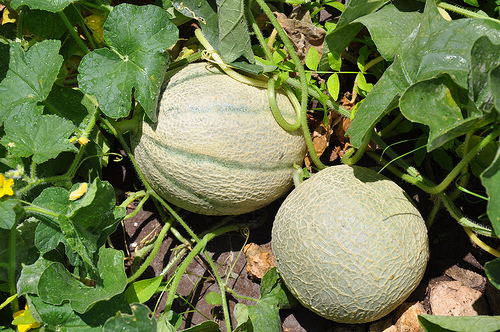Unused stories
Growing In Your Garden Now - Cantaloupes
Cantaloupes, Cucumis melo
Melons are members of the Cucurbitaceae Family. Most of the melons eaten in the United States are closely related members of the single genus Cucumis. This annual is likely native to Africa. Melons including musk, cantaloupe, honeydew, Crenshaw and casaba (all Cucumis melo) are eaten as fruit whereas some varieties of melons grown in Asia are in fact eaten as vegetables. The flesh of all melons, except watermelons, is derived from the ripening ovary wall. Watermelons, Citrullus lanatus, also native to Africa, have a distribution of seeds throughout the flesh which is placental. The Romans learned to grow cantaloupes from the Egyptians. Cantaloupes are named after the Roman town of Cantalupo, Italy.
Like all melons, cantaloupes need high temperatures, germinating only when soil temperatures reach 60 to 65°F and ripening best when air temperature is between 75 and 95°F. The majority of cantaloupes eaten in the U.S. are grown in California’s San Joaquin Valley and the southern desert areas of the state. In Marin, success growing any melon increases in the warmer valley areas of the county. With luck, you can grow cantaloupes by selecting early maturing varieties with small, sweet fruit such as ‘Lil Loupe’. Melons are large seeded plants best grown in Marin by direct seeding in late May to early June. Fruit development requires about 90 days and, like other members of the cucurbit family, development of male flowers occurs first followed by female blooms. Pollination is by honeybees.
Cantaloupes thrive in well fertilized soil with a pH around 6.5, full sun exposure and even moisture. Plant the seeds one inch deep and about six inches apart. After planting, fertilize with fish emulsion once every six weeks. The vining varieties sprawl along the ground but do make good candidates for trellising. You can grow cantaloupes in large containers, which increases soil temperature or plant them along stone walls which also retain heat. If trellised, fruit will need a sling support. If you want to plant cantaloupes in a flower bed, select a bush variety. Water evenly but never let the soil get soggy especially from flowering to fruit swell. It is important to remember that excess water or nitrogen shuts down the roots, stops photosynthesis and destroys the sugar in melon fruit. Almost half of the sugar content is developed in the last week of ripening. Reducing the water at this stage of development, enhances ripening and flavor.
The skin of a ripe cantaloupe changes from green to light yellow with a whitish net look on the surface. The best melon will be dense and weighty and have a fragrant, sweet smell. To harvest, the melon is ripe when the fruit separates from the vine, referred to as slip stage. The fruit will taste best one to two days after harvest with storage at 70°F. While the sugar content stops increasing at harvest, the melon will taste juicier. Wash the melon before cutting into its orange flesh. After cutting the cantaloupe, it is best to refrigerate until serving as this inhibits growth of harmful bacteria which can occur at room temperature. If you elect to save the seeds for next year’s planting, remove as much pulp as possible from the seeds. Place the seeds in a bowl of warm water and rinse any remaining juice and pulp. Discard any seeds that float as they will not produce plants. Dry them on a screen and when thoroughly dry, store in a jar away from light.
Selection of disease resistant varieties is important as melons are subject to the same diseases as cucumbers; powdery mildew, downy mildew, mosaic virus, verticillium wilt, blossom end rot and poor fruit set. Attract bees to your garden with companion plantings and give melons plenty of space to roam and grow.
By Anne-Marie Walker
